四年级英语上册公开课教案
人教英语精通版四年级上册_(优教课例)Unit3_lesson14_公开课教案【辽宁辽阳】

Unit3 lesson14 公开课教案【辽宁辽阳】授课教师:辽阳县隆昌镇九年一贯制学校杜冰洁一、教学目标与要求1. Just speak (知识目标)本部分继续学习使用What’s this in English? It’s a / an ... 以及询问对方是否喜欢某物Do you like ...? Yes, I do.能够在一定的情景中自然运用,达到使用所学语言进行简单交流的目的。
2. Just read and write (知识目标)本部分继续学习有关水果的单词:能够听、说、读、写的单词orange 和banana; 能够听、说、认读的单词有watermelon 和kiwifruit。
3. Let’s sing (知识目标)学唱Fruit song这首歌曲,复习巩固所学内容。
4. 德育目标使学生体会到良好饮食习惯的重要性。
二、教学重点单词watermelon, kiwifruit的认读及单词banana, orange。
三、教学难点在真实情景中运用所学句型进行交流。
四、课前准备1. 准备本课所学单词及上一节课所学单词的实物和图片。
2. PPT课件。
五、教学过程1. 热身/复习(Warm-up / Revision)(1) Let’s sing a song.(2) 用小游戏对所学的单词进行快速抢答What’s this in English? It’s a / an ... 复习所学的知识,为本课作铺垫。
2. 新课讲授(Presentation)(1) 用单词卡片PPT展示并教授本课出现的新词watermelon, kiwifruit, orange, banana. 以及它们的复数形式。
(2) 魔法手指、what’s missing? 游戏,巩固新单词。
(3) 课文对话展示并讲解,What are they talking about?板书单词banana,watermelon. 看动画视频,跟读本课对话,并能以小组的形式表演出来。
人教版小学四年级英语上册教案5篇
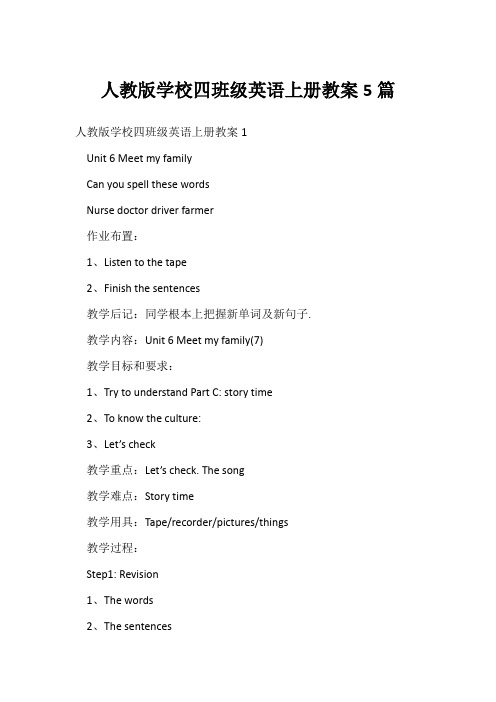
人教版学校四班级英语上册教案5篇人教版学校四班级英语上册教案1Unit 6 Meet my familyCan you spell these wordsNurse doctor driver farmer作业布置:1、Listen to the tape2、Finish the sentences教学后记:同学根本上把握新单词及新句子.教学内容:Unit 6 Meet my family(7)教学目标和要求:1、Try to understand Part C: story time2、To know the culture:3、Let’s check教学重点:Let’s check. The song教学难点:Story time教学用具:Tape/recorder/pictures/things教学过程:Step1: Revision1、The words2、The sentencesStep2:Finish ‘Let’s check〞1、Listen and chose the right answer.2、Check your answers.Step3: Story time1、Look at the pictures2、Try to understand the story3、Listen to the tape4、Say after the tapeStep4: CultureStep5: Let’s sing: Read the song1、Listen to the tape2、Sing togetherStep6:Summary and homework板书设计:Unit 6 Meet my family (7)Good to know. Mom mother作业布置:1、Listen to the tape2、Sing the song.教学后记:同学的练习反应状况较好。
PEP小学英语四年级上册 《Unit1 My classroom》公开课教案

PEP Book 3 Unit 1 My classroom巩固提升【教材分析】本节课是 Unit 1 My classroom的巩固提升课,是本单元的最后一课时,本单元围绕教室这个话题展开,学生能够听、说、认读单词classroom, window, blackboard, light, picture, door, teacher’s desk, computer, fan, wall, floor,能用What’s in the classroom? …来问答教室物品;能用Where is …? It’s in/on/under/near…描述物品位置。
本课时通过归纳总结单词与重句,引领学生从宏观上把握知识点之间的联系。
通过一系列的输出和拓展活动如描述教室、摆放物品等,使学生在真实的语境下达到语言知识的内化并输出,在合作交流讨论的基础上,全面提升学生的综合语言运用能力。
思维导图的拓展性运用发展了学生的创造性思维和能力,将知识融会贯通。
【教学目标】知识与技能目标:1. 所有学生能够听、说、认读单词classroom, window, blackboard, light, picture, door, teacher’s desk, computer, fan, wall, floor2. 绝大部分学生能够根据给出的课本图片、视频或者框架回忆、复述文本内容。
3. 大部分学生能够根据已学的单词与重句谈论自己的教室。
过程与方法目标:1. 通过单词大比拼、读一读、想一想等,学生能够回顾单词与重句。
2. 通过读图片、角色扮演等途径,学生能够复述文本。
3. 通过画自己教室的思维导图培养学生的归纳总结对比的能力。
4. 通过pair work 和group work等形式培养学生合作意识和语言交际能力。
情感态度与价值观目标:学生能热爱教室,保持教室干净整洁。
【教学重难点】重点:1.能用what’s in the classroom? …来问答教室物品;能用Where is …?It’s in/on/under/near…描述物品位置。
人教PEP版四年级英语上册《Recycle1》精品教案教学设计小学优秀公开课3
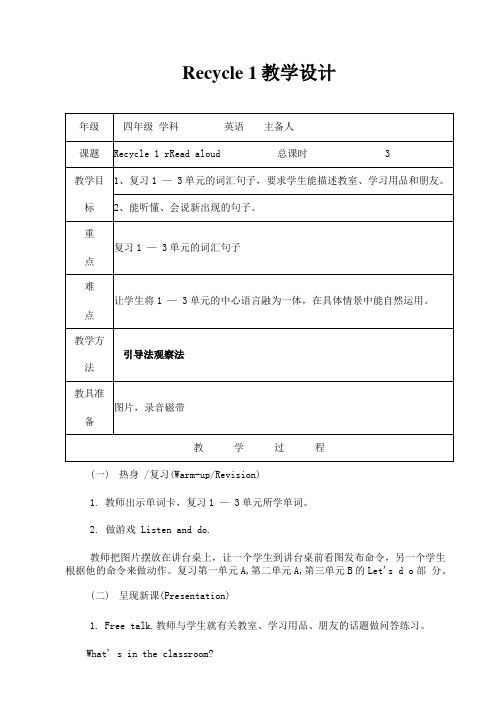
Recycle 1教学设计(一)热身 /复习(Warm-up/Revision)1.教师出示单词卡,复习1 — 3单元所学单词。
2.做游戏 Listen and do.教师把图片摆放在讲台桌上,让一个学生到讲台桌前看图发布命令,另一个学生根据他的命令来做动作。
复习第一单元A,第二单元A,第三单元B的Let's d o部分。
(二)呈现新课(Presentation)1.Free talk.教师与学生就有关教室、学习用品、朋友的话题做问答练习。
What' s in the classroom?12.教师给学生展示第四段对话。
并让学生回答问题:What' s Amy' s teacher' s name?13.让学生听Connect and say录音进行连线。
Kate-name-race-lake-game;Mike-nine-fine-time-side;Rose-note-Jones-Coke-hope;这三组重点练习a-e, i-e在单词中的发音,可以给一些生词让学生根据发音规律拼读,如:same, take, bake, hate, hide, wide, bite, those 等。
Tim-win-big-milk-fit;Bob-dog-hot-Tom-doll;这两组重点学习元音字母i,。
在重度闭音节中的发音,可以给出一些生词让学生拼读,如:shop, job, dot等来掌握它们的发音。
14.播放录音让学生完成Look, listen and write中的内容,进一步练习元音字母的发音:(1). Kate likes to make rice . (cakes)(2). Five mice ride a nice . (bike)(3). Mr Jones phones me at .(home)(三)趣味操练(Practice)1.玩“猜人”游戏。
人教PEP四年级英语上册Unit3_C_Story_time 公开课教案

Unit3 C Story time公开课教案一、教学目标知识与能力:1. 能够听懂、会说故事中出现的重点短语。
2. 学生能理解故事内容;能基本朗读故事;基础较好的学生能够表演故事。
情感态度价值观:结合我校英语组善“SHOW”的课堂理念,通过感知、理解、表演拔萝卜的故事,培养学生互帮互助、团结合作的精神,使其明白“团结就是力量”的道理。
二、学情分析鉴于我校一年级开设英语课,四年级阶段的学生有一定的英语基础,能够借助旧词自然拼读新单词,因此授课中重点关注学生对故事内容的整体理解及人文素养培养。
三、重点难点重点:1. 理解并掌握重点句型:I can’t pull it up. Come on, friends, please help me. Let’s work together.2. 理解故事大意并朗读故事。
难点:表演故事、感受团结就是力量。
四、教学过程活动1【导入】Lead inGreet Ss with daily expressions.活动2【讲授】Pre-reading(1) Play a guessing game.T: Before the class, let’s play a guessing game! Who can read it?S1: She is my friend. She has ...Ss: It’s you. Yuki.T: You are so clever. It’s me. Look, I have a ... Now, could you please talk about your friend? (Tips about vocabulary for Ss)S1: …S2: ...T: Today, I’ll introduce an animal friend. It has a small nose, a small mouth, 2 big eyes, and 2 long ears. Guess, who’s she?S1: Rabbit.T: Yes! But do you know what does a rabbit like to eat? Guess?Ss: cabbages / apples / bananas / vegetables…T: They also like to eat turnip.(拿出实物萝卜)引导学生运用自然拼读法拼读该单词。
四年级上册英语教案Module9Unit1公开课
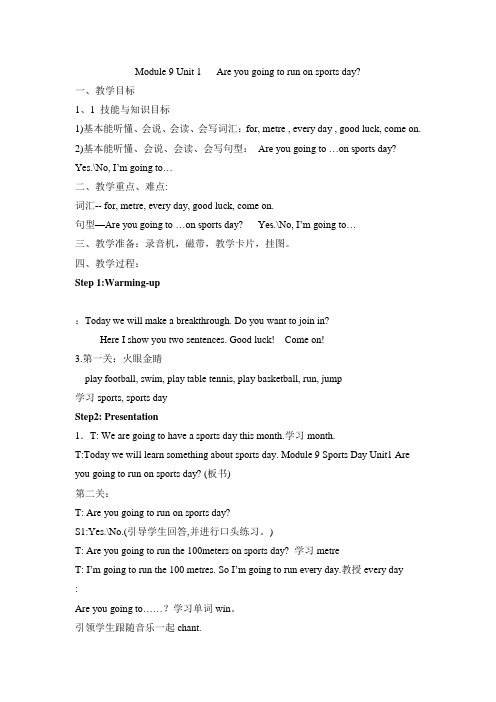
Module 9 Unit 1 Are you going to run on sports day?一、教学目标1、1 技能与知识目标1)基本能听懂、会说、会读、会写词汇:for, metre , every day , good luck, come on.2)基本能听懂、会说、会读、会写句型:Are you going to …on sports day? Yes.\No, I’m going to…二、教学重点、难点:词汇-- for, metre, every day, good luck, come on.句型—Are you going to …on sports day? Yes.\No, I’m going to…三、教学准备:录音机,磁带,教学卡片,挂图。
四、教学过程:Step 1:Warming-up:Today we will make a breakthrough. Do you want to join in?Here I show you two sentences. Good luck! Come on!3.第一关:火眼金睛play football, swim, play table tennis, play basketball, run, jump学习sports, sports dayStep2: Presentation1.T: We are going to have a sports day this month.学习month.T:Today we will learn something about sports day. Module 9 Sports Day Unit1 Are you going to run on sports day? (板书)第二关:T: Are you going to run on sports day?S1:Yes.\No.(引导学生回答,并进行口头练习。
最新人教PEP版小学英语四年级上册 Unit 4 第5课时公开课教学设计
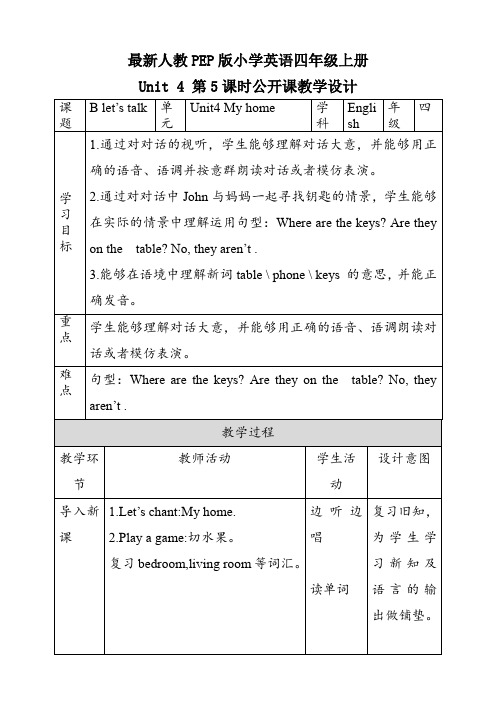
听音正音
分角色朗读
对话练习
创编对话
看视频
问答练习
通过不同的活活动,来巩固对话内容,以此加深对对话文本结构的印象,同时充分调动学生的积极性。
课堂小结
What have you learned today?
板书
Unit4 My home B Let’s talk
教师活动
学生活动
设计意图
导入新课
1.Let’s chant:My home.
2.Play a game:切水果。
复习bedroom,living room等词汇。
边听边唱
读单词
复习旧知,为学生学习新知及语言的输出做铺垫。
讲授新课
师通过提问Where are your pens?Are they in/on/near the…?引导学生运用已学过的方位介词来回答。初步渗透复数句型的用法。
Are they on the table? Are they near the phone?在提出问题的同时,学习新词table和phone(desk和table对比学习,用拆音法学习phone,ph-o-n-e.)
第二遍观看课文视频,选择正确的答案。
3.The keys are not on the table. And they are not near the phone. Where are they?
让学生两人一组,一人在图中的圆圈里写上单词的首字母代表该物品所在的位置,不让对方看到,对方要通ohn房间物品的摆放!
A: Where is/ are the ?
B: Is it/ Are they the ?
最新沪教版小学英语四年级上册《Attheshop》公开课教学设计

最新沪教版小学英语四年级上册《Attheshop》公开课教学设计《At the shop》教案教学目标Teaching Aims:1.知识目标:1) Using formulaic expressions to request something2) Using formulaic expressions to reply requests2.能力目标:1) Open/maintain an interaction by eliciting a response2) Use modeled sentences to communicate with other learners3.情感目标:要求学生在生活实际中帮助家长做些力所能及的家务如购物教学重点1单词:apple, apples, banana, bananas, orange, oranges, pear, pears. 2句型:用How much is it?How much are they? 的句型来询问价钱。
教学难点1.利用语音知识来规范孩子有关水果单复数的读法。
2.通过创设情景,学习询问水果价钱的句型。
(在情景中学习句型,进行模仿性操练)3. 注意让孩子区分买单个水果,和很多个水果的问句与答句。
(利用口诀及歌曲歌谣教学法)教学准备课件, 图片等教学课时第1课时教学过程教学建议1. Teaching contents(P14, 13)New words: apple, apples, banana, bananas, orange, oranges, pear,pears.Sentences: How much is it? It’s …..yuan.How much are they? They’re ….yuan.2. Teaching procedures:Step1: Greetings.T: Hello, boys and girls.Ss: Hello, Amy.T: How are you?Ss: Fine, thank you. And you?T: Very well. Thanks.Step2: Sing a song.Step3: Lead in.Show the pictures and say : one pencil , six bananas, seven pears and etc.Step4: Presentation1.Learn the new words: banana, pear, apple ,orange( usingpictures and realia) Say the word together.2.Plural phrases: six bananas, ten pears, seven apples,nine oranges.Step5: Practice3.(show a picture of a supermarket) Tell a story like this:It’s eleven o’clock. So I want to eat some fruits.Then I go to the fruit shop. First I want to anapple. Second, I want to buy some bananas.A : An apple , please.How much is it?B: It’s five yuan.A : Eight bananas, please.How much are they?B: They’re ten yuan.5. Play the computer and try to understand the meaning.Step6: Production6. Listen and repeat7. Act out the dialogue. ( one is the shop assistant , the other is the customer.A : An/ a……. , please.How much is it?。
人教PEP版四年级英语上册《Unit 1 第2课时》教学设计教案小学公开课
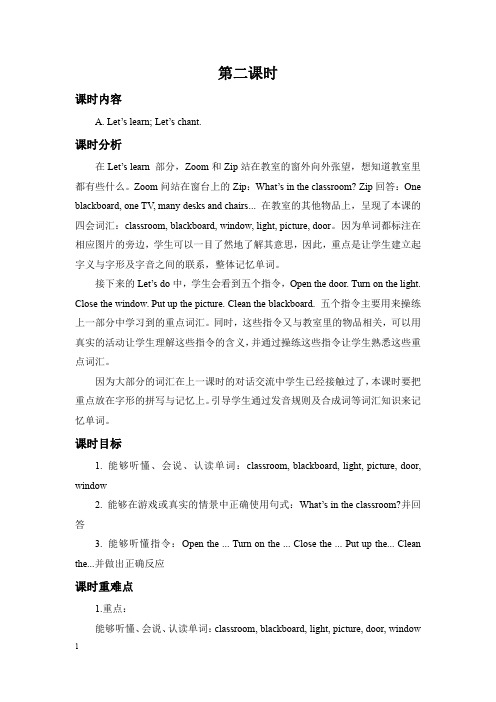
第二课时课时内容A.Let’s learn;Let’s chant.课时分析在Let’s learn部分,Zoom和Zip站在教室的窗外向外张望,想知道教室里都有些什么。
Zoom问站在窗台上的Zip:What’s in the classroom?Zip回答:One blackboard,one TV,many desks and chairs...在教室的其他物品上,呈现了本课的四会词汇:classroom,blackboard,window,light,picture,door。
因为单词都标注在相应图片的旁边,学生可以一目了然地了解其意思,因此,重点是让学生建立起字义与字形及字音之间的联系,整体记忆单词。
接下来的Let’s do中,学生会看到五个指令,Open the door.Turn on the light. Close the window.Put up the picture.Clean the blackboard.五个指令主要用来操练上一部分中学习到的重点词汇。
同时,这些指令又与教室里的物品相关,可以用真实的活动让学生理解这些指令的含义,并通过操练这些指令让学生熟悉这些重点词汇。
因为大部分的词汇在上一课时的对话交流中学生已经接触过了,本课时要把重点放在字形的拼写与记忆上。
引导学生通过发音规则及合成词等词汇知识来记忆单词。
课时目标1.能够听懂、会说、认读单词:classroom,blackboard,light,picture,door, window2.能够在游戏或真实的情景中正确使用句式:What’s in the classroom?并回答3.能够听懂指令:Open the...Turn on the...Close the...Put up the...Clean the...并做出正确反应课时重难点1.重点:能够听懂、会说、认读单词:classroom,blackboard,light,picture,door,window能够在游戏或真实的情景中正确使用本课单词及句式:What’s in the classroom?2.难点:能够听懂指令:Open the...Turn on the...Close the...Put up the...Clean the...并做出正确反应教学准备1.多媒体课件、录音机、磁带2.教室内物品的单词图卡教学过程✪Step1Warm up1.与学生互致问候之后,请学生注意自己带到教室里的物品,并根据其位置呈现韵句。
PEP人教版四年级英语上册《Unit2-A-Let’s-spell公开课教案》
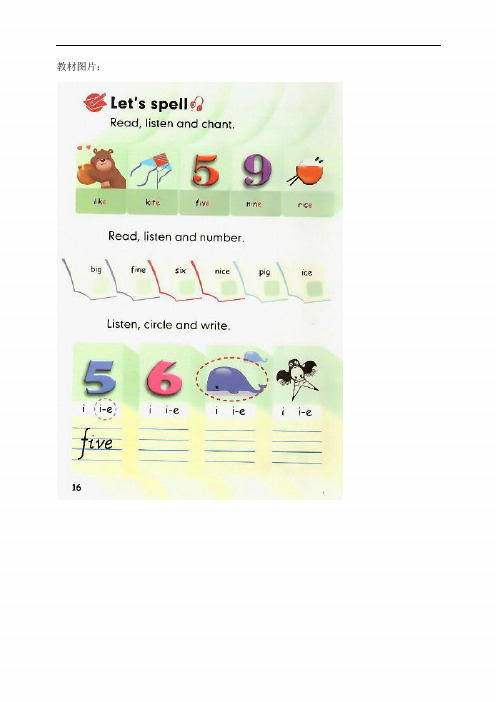
教材图片:Unit2 Part A Let’s spell教材:人教PEP小学英语四年级上册P16单元主题:My schoolbag课型:语音课一、教材解析本课时是PEP小学英语四年级上册Unit2的第三课时,学习i-e在单词中发字母本身音/aɪ/的规则。
本部分通过例词让学生感知并归纳i-e在单词中的发音规则,辨别i/i-e的不同发音,听音写单词,为提升阅读能力打下基础。
,二、目标预设1. 能够感知并归纳i-e在单词中的发音规则,能够读出符合i-e发音规则的单词。
2. 能够根据单词的读音拼写出符合i-e发音规则的单词。
三、重难点预设教学重点:i-e在单词中的发音规则。
教学难点:根据发音拼写出符合i-e发音规则的单词;/aɪ/不容易发到位。
四、教学过程(一)热身/导入(Warm-up/Lead-in)[1. 师生相互问候,练习课堂口语。
2. 播放Unit1 A Let’s spell学习过的语音歌谣,学生跟唱,复习a-e的发音的同时,进行课堂热身。
3. 出示单词cake, face, name, make,引导学生复习a-e的发音。
【设计意图】复习a-e的发音,帮助学生巩固所学内容,同时为学习i-e的发音做准备。
(二)呈现新课(Presentation)1. 教师自编关于Zoom的故事,引出含有i-e结构的单词:like, kite, five, nine, rice。
Zoom is nine years old.He likes rice.?He has five kites.【设计意图】通过给学生讲故事,激发学生的好奇心,以此引出本课语音词汇,可以让学生对新授内容更感兴趣并集中注意力。
2. 教师板书单词:like, kite, five, nine, rice,并把i-e标红,引导学生找出共同点:以上单词都含i-e结构,发音都为/aɪ/。
教师引导学生用自然拼读法拼读单词:like: /l/-/aɪ/-/k/, /laɪk/kite: /k/-/aɪ/-/t/, /kaɪt/five: /f/-/aɪ/-/v/, /faɪv/nine: /n/-/aɪ/-/n/, /naɪn/%rice: /r/-/aɪ/-/s/, /raɪs/【设计意图】通过呈现含有i-e的单词及发音,引导学生观察并总结其发音。
人教PEP版四年级英语上册《Unit1》精品教案教学设计小学优秀公开课5
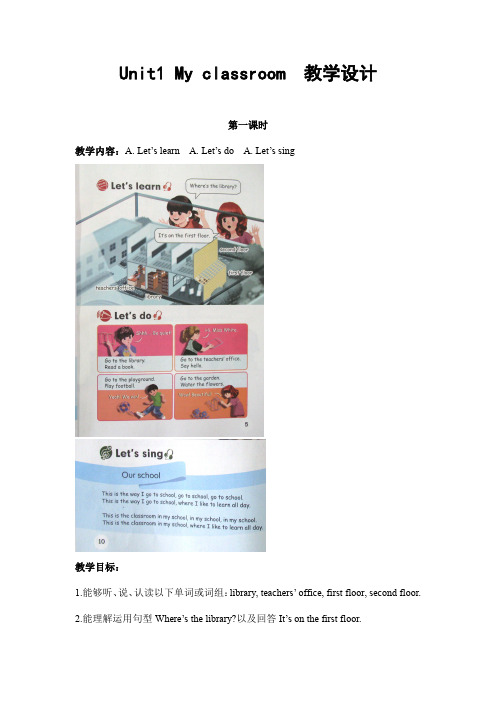
Unit1My classroom教学设计第一课时教学内容:A.Let’s learn A.Let’s do A.Let’s sing教学目标:1.能够听、说、认读以下单词或词组:library,teachers’office,first floor,second floor.2.能理解运用句型Where’s the library?以及回答It’s on the first floor.3.能听懂指示语,并按照指令做出相应的动作,如:Go to the library.Read a book. Go to the teachers’office.Say hello.Go to the playground.Play football.Go to the garden.Water the flowers.4.会唱歌曲《Our school》教学重点:能够听、说、认读以下单词或词组:library,teachers’office,first floor, second floor.能理解运用句型Where’s the library?以及回答It’s on the first floor.教学难点:正确使用序数词,the first floor,the second floor.教学准备:1.单词卡片。
2.课件。
3.录音机和磁带。
4.板书教学过程:一、热身1.师生对话:T:Nice to see you again.How are you?Ss:I’m fine.Thank you. T:Welcome back to school.Let’s talk about our school.OK?(板书课题:Unit1My school)2.Listen to the song Our school.(学生边听音乐,边随着音乐做动作。
)3.Revision:T:(指着教室)What’s in the classroom?S:Two blackboards,a computer, many desks and chairs…T:How many classrooms are there in our school?Ss: There are…(旨在复习四上Unit1My classroom的相关单词和句型。
人教英语精通版四年级上册_Unit5_Lesson28_公开课教案【湖北潜江】
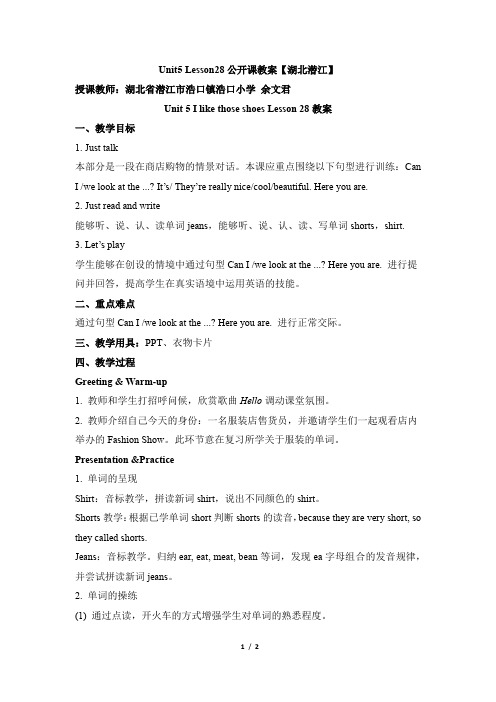
Unit5 Lesson28公开课教案【湖北潜江】授课教师:湖北省潜江市浩口镇浩口小学余文君Unit 5 I like those shoes Lesson 28教案一、教学目标1. Just talk本部分是一段在商店购物的情景对话。
本课应重点围绕以下句型进行训练:CanI /we look at the ...? It’s/ They’re really nice/cool/beautiful. Here you are.2. Just read and write能够听、说、认、读单词jeans,能够听、说、认、读、写单词shorts,shirt.3. Let’s play学生能够在创设的情境中通过句型Can I /we look at the ...? Here you are. 进行提问并回答,提高学生在真实语境中运用英语的技能。
二、重点难点通过句型Can I /we look at the ...? Here you are. 进行正常交际。
三、教学用具:PPT、衣物卡片四、教学过程Greeting & Warm-up1. 教师和学生打招呼问候,欣赏歌曲Hello调动课堂氛围。
2. 教师介绍自己今天的身份:一名服装店售货员,并邀请学生们一起观看店内举办的Fashion Show。
此环节意在复习所学关于服装的单词。
Presentation &Practice1. 单词的呈现Shirt:音标教学,拼读新词shirt,说出不同颜色的shirt。
Shorts教学:根据已学单词short判断shorts的读音,because they are very short, so they called shorts.Jeans:音标教学。
归纳ear, eat, meat, bean等词,发现ea字母组合的发音规律,并尝试拼读新词jeans。
2. 单词的操练(1) 通过点读,开火车的方式增强学生对单词的熟悉程度。
四年级上册公开课英语教案
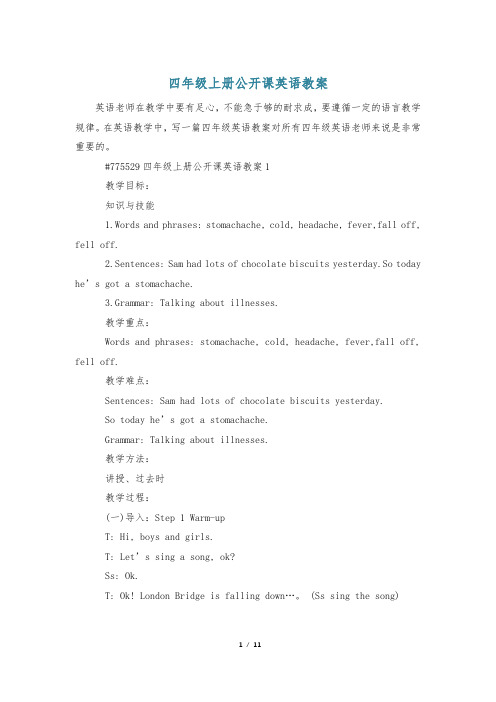
四年级上册公开课英语教案英语老师在教学中要有足心,不能急于够的耐求成,要遵循一定的语言教学规律。
在英语教学中,写一篇四年级英语教案对所有四年级英语老师来说是非常重要的。
#775529四年级上册公开课英语教案1教学目标:知识与技能1.Words and phrases: stomachache, cold, headache, fever,fall off, fell off.2.Sentences: Sam had lots of chocolate biscuits yesterday.So today he’s got a stomachache.3.Grammar: Talking about illnesses.教学重点:Words and phrases: stomachache, cold, headache, fever,fall off, fell off.教学难点:Sentences: Sam had lots of chocolate biscuits yesterday.So today he’s got a stomachache.Grammar: Talking about illnesses.教学方法:讲授、过去时教学过程:(一)导入:Step 1 Warm-upT: Hi, boys and girls.T: Let’s sing a song, ok?Ss: Ok.T: Ok! London Bridge is falling down…。
(Ss sing the song)T: You are clever boys and girls. Now let’s have a Free Talk “What I didyesterday”, Ok?Ss introduce what they did yesterday(二)探究新知Step 2 Presentation and leadingT: Who can tell me what happen to Daming in last Unit.Ss: Daming’s head was bumped.T: Let’s play this story, ok?Ss: Ok.(Two students play in roles of “Daming” and “Sam”, others describe thestory, the two students do the actions)The teacher writes the word “today” on the blackboard. What happened toDaming, Sam, Amy and Lingling? Lead the students to use “to” and “and” toconnect the two sentences.Step 3 Text TeachingT: Now, this class we are going to learn Module 10 Unit 2 Sam had lots ofchocolate biscuits .First, listen to the tape and underline the new words.(Teach the new words’ cards)T: Now listen to the tape and repeat it. Are you clear?(The teacher writes these sentences on the blackboard)Sam had lots of chocolate biscuits yesterday.So today he’s got a stomachache.T: Now listen to the tape again and tell me what happened to Sam, Lingling,Amy and Lingling.T: Look at these words: had, ate(三)巩固新知Step 4 Task-FulfillingT: Let’s play a game, ok? Ss: Ok.T: Let’s play “I do you say”。
人教版小学英语精通版四年级上册《Unit 1 This is my new》优质公开课件教案

人教版小学英语精通版四年级上册《Unit 1 This is my new Lesson 6》优质课公开课课件、教案人教精通版四年级上册Lesson 6一、教学目标依据本课的教学内容及知识与技能、过程与方法、情感态度与文化意识有机结合的原则,我将本课的具体教学目标设计如下:1.能听、说、认读单词:TV reporter, policeman.2.在游戏活动中,帮助学生灵活运用本单元所学表示职业的词汇进行职业介绍。
3.在小组合作学习活动中,引导学生正确运用句型:What does …… do?询问他人的职业信息。
4.通过趣味小故事的阅读和表演,提高学生自主阅读和综合运用语言的能力。
5.通过歌曲、韵律、游戏、表演等多样化的教学活动等不同的评价形式激发学生大胆发言,培养积极合作的学习品质。
6.使学生对不同职业的意义有更深一步的认知,从而形成良好的职业理想。
7.在本课教学中,有效引导学生感知家庭的温暖,培养学生热爱、感恩家人的优秀品质。
二、教学重点在真实的语言环境,学生能正确运用句型:Who’s this ……?He/She’s …… What does your …… do? He/She’s a/an …… 问答人物及人物的职业.正确理解、表演本课小故事,提高学生语言综合运用能力。
通过本课教学,引导学生热爱家庭、孝敬父母的积极情感。
三、教学难点在各项教学活动中,有效引导学生正确理解、灵活运用重点词句表情达意。
充分发挥多媒体课件的作用,较好利用课堂资源,提高课堂教学的实效性。
四、教学活动1、Warm-up(一)Warm-up1. Sing an English song—“ I love my family.” together.T: Who’s this man/ woman?S1: He’s the girl’s father. (Show the first letter “f” on the picture)S2: She’s the girl’s mother. (Show the first letter “m” on the picture)T: Do you love your father and mother?Ss: Yes. Father and mother, I love you!Teach the word: family通过播放歌曲营造轻松、愉快的课堂氛围。
人教PEP四年级英语上册 Unit2_C_Story_time公开课教案
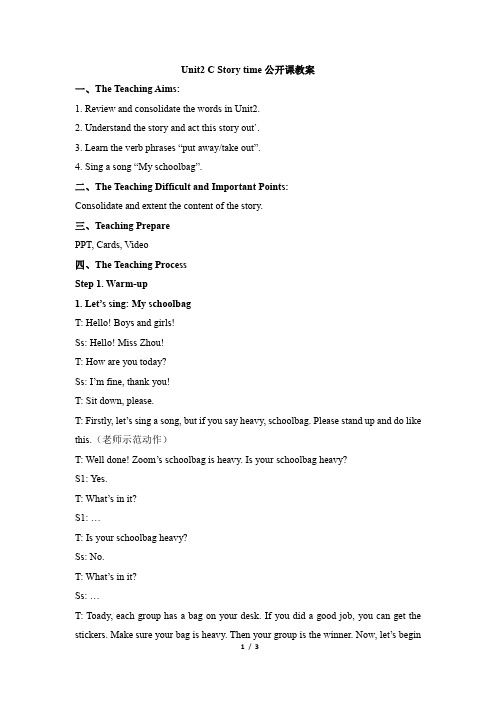
Unit2 C Story time公开课教案一、The Teaching Aims:1. Review and consolidate the words in Unit2.2. Understand the story and act this story out`.3. Learn the verb phrases “put away/take out”.4. Sing a song “My schoolbag”.二、The Teaching Difficult and Important Points:Consolidate and extent the content of the story.三、Teaching PreparePPT, Cards, Video四、The Teaching ProcessStep 1. Warm-up1. Let’s sing: My schoolbagT: Hello! Boys and girls!Ss: Hello! Miss Zhou!T: How are you today?Ss: I’m fine, thank you!T: Sit down, please.T: Firstly, let’s sing a song, but if you say heavy, schoolbag. Please stand up and do like this.(老师示范动作)T: Well done! Zoom’s schoolbag is heavy. Is your schoolbag heavy?S1: Yes.T: What’s in it?S1: …T: Is your schoolbag heavy?Ss: No.T: What’s in it?Ss: …T: Toady, each group has a bag on your desk. If you did a good job, you can get the stickers. Make sure your bag is heavy. Then your group is the winner. Now, let’s beginour match —Look and remember. Ready? Go! Discuss in your group and put the stickers on the board.(小组讨论,贴相应的物品的贴纸在纸板上。
- 1、下载文档前请自行甄别文档内容的完整性,平台不提供额外的编辑、内容补充、找答案等附加服务。
- 2、"仅部分预览"的文档,不可在线预览部分如存在完整性等问题,可反馈申请退款(可完整预览的文档不适用该条件!)。
- 3、如文档侵犯您的权益,请联系客服反馈,我们会尽快为您处理(人工客服工作时间:9:00-18:30)。
Unit 5 I like noodles
Period 1
【教学目标】:
1、语言目标:
A、词汇:能听懂,会说,认读,会写新单词noodle(s)(复数);能听懂,会说,认读新单词biscuit, bread, dumplings, hungry, rice.
”询问他人及表达个人
B、句型:能用“what do you like?”“I like /don’t like…
的喜好。
2、应用目标:
A、指认食品单词。
B、能简单区分单词的单复数形式。
C、能听懂,会说A部分的对话。
【教学重难点】
1、重点:能听懂,会说,认读,会写新单词noodle(s)(复数);能听懂,会说,认读新单词biscuit, bread, dumplings, hungry, rice. 能用“what do you like?”I like /don’t like…”询问他人及表达个人的喜好。
2、难点:简单区分食品单词的单复数形式。
【教学准备】
幻灯片多媒体课件、图片。
【教学过程】
Step1 warm-up.
Greetings.
Step2 Presentation.
1、New words.
(1)、hungry
引出“hungry”这个单词,能够引出本课话题。
出示课件(或图片)解释“hungry”的有关含义与用法,教读单词,然后进行对话。
T: I’m h ungry. Are you hungry?
Ss: I’m hungry.
(2)、biscuit
出示课件(或图片)认识biscuit,解释biscuitS的复数形式,教读单词,然后进行对话。
T:I like biscuits. What do you like?
Ss:I like biscuits.
(3)、noodle(s)
引出“noodles”这个单词,能够引出视频单词的复数形式。
出示课件(或图片)解释noodles常以复数形式出现,教读单词,然后进行对话。
T: I like noodles. What do you like?
Ss: I like noodles.
(4)、dumpling
引出“dumpling”这个单词,出示课件(或图片)解释“dumpling”的复数形式,教读单词,然后进行对话。
T:I love dumplings.
Ss: I love dumplings.
(5)、milk
出示课件(或图片)解释milk的单复数变化,教读单词,然后进行对话。
T:I like milk。
Ss: I like milk./I don’t like milk.
(6)、rice
引出中西方不同的食品及饮食习惯。
出示图片解释“rice”的单复数变化,教读单词,然后进行对话。
T: I like rice. What do you like?
Ss: I like rice。
(7)、bread
出示课件(或图片)解释“bread”的单复数变化,教读单词,然后进行对话。
T:I don’t like bread.
Ss: I like bread./I don’t like bread..
2、词汇操练
(1)、游戏:Guess,guess,guess!
分组进行游戏。
一组做动作表演所吃的食物,另一组猜一猜他们所吃的食品是什么。
(练习单词的同时,培养学生的观察力与注意力)
(预测:难点为-S的发音。
对于-S的发音,一定要强调)
(2)、活动:给表情配句子。
用课件或单词卡片出示食品图片,学生做表情,其他学生配句子。
“I like ”
/don’t like…
”来表达个人的喜好)(此(预测:要让学生能够自由地用“I like /don’t like…
处渗透食品安全相关知识,如《中华人民共和国食品安全法》中“第八条国家鼓
励社会团体、基层群众性自治组织开展食品安全法律、法规以及食品安全标准和知识的普及工作,倡导健康的饮食方式,增强消费者食品安全意识和自我保护能力。
同时,渗透中华民族的有关传统美德,让学生自己增强珍惜粮食的意识。
)
3、The dialogue
课文学习:分部引导学生熟悉课文。
第一步:Listen and fine.不打开书,只听音,听音前,给出任务:你听到孩
子们提到了那些食品?
第二步:Listen and find
打开书,听音,画出不懂的句子和单词,同时检查刚才自己听到的是否正确。
第三步:Read
教读,师生共同朗读对话;师生互动,教师读句子,在哪里停下来,学生就
接着往下读,看谁接得又快又准。
Step3 practice.
1、Chant
hungry →What do you like? ↓
noodles, noodles, noodles (面条)
I like biscuits biscuits biscuits (饼干)
dumplings, Dumplings, Dumplings, (饺子)
I don’t like milk. mlik. Milk (牛奶)
rice rice, rice (米饭)
bread, bread, bread (面包)
2、分层任务巩固所学内容,由学生根据自身水平和兴趣自由选择任务任务
完成。
Step4 Homework
1、把课文读给父母听。
2、分组准备课文B部分的食品单词卡片。
【板书设计】
Unit 5 I like noodles
hungry →What do you like? ↓
↓noodles(面条)
I like biscuit(s)(饼干)
↓dumplings(饺子)
I don’t like milk(牛奶)
rice(米饭)
bread (面包)。
